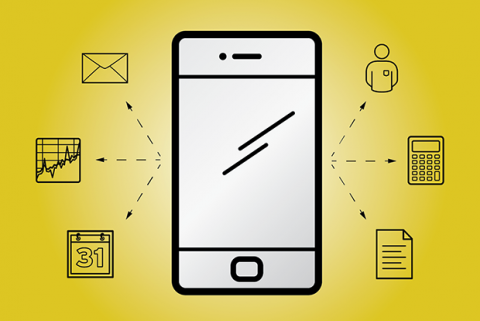In the early days of smartphones, the first enterprise mobile apps were often simple informational apps in public apps stores designed for a company’s end customers. Since then, many organizations have evolved to developing custom apps that streamline, automate or reinvent customer-facing and employee-centric business processes. As organizations try to cope with the ever-increasing demand from the business for more apps, we see the emergence of rapid development tools that empower the citizen developer and enable the business to move forward with their initiatives.
The pace of change is unrelenting and mobile is increasingly seen as less of a standalone app project and more integral to a wider digital initiative that spans the Internet of Things (IoT), business process management, data analytics, augmented reality, and more. New areas that are gaining attention and we think will grow in 2017 are ambient intelligence (AmI) and artificial intelligence (AI).
Mobile is getting smarter
While mobile apps continue to be a prime focus for the enterprise, there is an increasing interest (some might say hype) around artificial intelligence (AI) with chatbots and Personal Digital Assistants (think Siri, Cortana, Alexa and Google) being the latest tech craze, driven by the leading technology companies like Google, Amazon and Facebook. Artificial intelligence, by definition, is intelligence exhibited by machines to display them as rational agents that can perceive their surroundings and make decisions. A rational agent defined by humans would be a computer that can realistically simulate human communication. AI is becoming a reality as technological advancements in natural language processing, big data, mobile, sensors, and cloud come together in a perfect storm.
At the same time, the term ambient intelligence is gaining momentum. A TechCrunch article this year described ambient intelligence (AmI): “Ambient intelligence is born of digital interconnectedness to produce information and services that enhance our lives. This is enabled by the dynamic combination of mobile computing platforms, the cloud and big data, neural networks and deep learning using graphics processing units (GPUs) to produce artificial intelligence (AI).”
One example of ambient intelligence is a smart building that can respond and learn from human behavior through the combination of advanced sensors and mobile devices that interpret human actions (location, facial images, temperature, etc.). Early examples of ambient intelligence are smart building systems that respond to the presence of people and their environment switching heating and lighting accordingly.
What enterprises need to know for 2017
2017 will see an increase in both the hype and the application of chatbots, especially in consumer-facing scenarios where “chat” offers a voice-controlled user interface. These so-called bots and personal digital assistants will play a bigger role in making apps more user-friendly, but more importantly, they will provide greater utility as we continue down the road of technology disruption in the enterprise.
While AI and AmI are hot topics that will continue to consume some mindshare among businesses in 2017, their use is still very much targeted at consumer-facing applications. To date, these technologies haven’t had much application in employee-facing processes, but that is yet to come. The path that AI/AmI will take is likely to follow that of mobile apps where initial experimentation will be around consumer-facing applications with basic features and simple integration. This will then evolve toward more complex applications that integrate with multiple data sources and extend to other internal business and employee workflows.
Likewise, the challenges that face AI may somewhat mirror those of mobile – i.e. security, adoption, usage, performance, integration, and data management. The pace of change will demand even greater speed of development and delivery that can be supported by platform technologies based on cloud native application development, microservices architectures, agile and user-centric processes, and modern technologies that support agility and scaling.
So although AI may grow in mindshare going into 2017, we don’t anticipate it being a significant business initiative for all but a small fraction of companies. For most companies, there is still a lot of work to be done in transforming their IT organizations for a digital, rapidly-evolving market and dealing with more tactical issues such as securing mobile access to data, backend integration of apps with legacy systems, implementing API-based architectures, and adopting agile development methods.
Multiple surveys reveal that while the majority of organizations have implemented a mobile app strategy, they still are not creating and deploying the volume of apps that would be expected. A recent survey sponsored by Red Hat among healthcare organizations in the United States and Europe showed that even in very large organizations with more than 7,500 employees, the average number of mobile apps created to date is only 19. That’s pretty low considering the opportunities that mobile apps can provide to enhance customer engagement and drive internal productivity. Can such businesses add AI projects to their digital strategy? Maybe, but they need to tackle some of the remaining challenges that they face in mobile app development and apply the learnings to adopting chatbots.





Comments
Hi Grant,
I just stumbled across your post on “Mobile app development gets smarter in 2017” and really loved how you broke down the information. In fact, I recently wrote a blog post with “Why Should You Give More Weight age To Mobile App Than Business Website?” that takes Mobile Apps Development Service come to rescue by enabling to avail facilities at your fingertips.
link:- goo.gl/typPUz
I thought it might be of interest to you!
Thanks for sharing useful information about app development. Hybrid technologies is one of important Technology who make app development smarter in 2017. We at App development company Agicent also write a lot about mobile apps development topics on our blog, check our website for more such info.https://www.agicent.com/blog/
@Manoj yes you are right the demand of hybrid mobile app will increase in 2017.
Thanks for this article. We recently published an article on the value of enterprise app development. Feel free to take a look: https://michiganlabs.com/business/2016/12/08/value-in-enterprise-apps/
Nice article its help me lots thank author and awaiting for your new update.
https://www.omsoftware.net/
Thanks for sharing such a valuable information. Before reading this article I gone with another article shared about UI design trends in 2017 it was also nice one please go through with the following link
https://krify.co/top-mobile-ui-design-trends-to-expect-in-2017/
Hi Grant,
I just stumbled across your post on “Mobile app development gets smarter in 2017” and really loved how you broke down the information. In fact, I recently wrote a blog post with “Why Should You Give More Weight age To Mobile App Than Business Website?” that takes Mobile Apps Development Service come to rescue by enabling to avail facilities at your fingertips. https://www.proleadsoft.com/mobile-app-development/